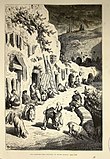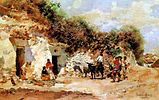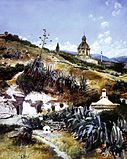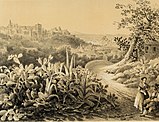Sacromonte: Difference between revisions
m image->file; tidy |
No edit summary |
||
| Line 47: | Line 47: | ||
=== Abbey and College of the Sacromonte; ''Holy Caves'' === |
=== Abbey and College of the Sacromonte; ''Holy Caves'' === |
||
In addition to the numerous caves, the main monument of the neighborhood is the [[Abbey of Sacromonte]], built by Archbishop Pedro de Castro y Quiñones in 17th century at the top of the hill, where appeared the alleged relics and other remains that would have been of the first Christians of Granada and [[Evangelization|evangelizers]] of the Roman [[Hispania Baetica|Baetica]], including Saint Caecilius, [[martyr]] and first bishop of the city, in the 1st century AC, and other apostolic figures, companions of [[James, son of Zebedee|Saint James]]. Annex to the abbey also found the College of Sacromonte, founded also by Pedro de Castro.<ref name=gg1 /> |
In addition to the numerous caves, the main monument of the neighborhood is the [[Abbey of Sacromonte]], built by Archbishop Pedro de Castro y Quiñones in 17th century at the top of the hill, where appeared the alleged relics and other remains that would have been of the first Christians of Granada and [[Evangelization|evangelizers]] of the Roman [[Hispania Baetica|Baetica]], including Saint Caecilius, [[martyr]] and first bishop of the city, in the 1st century AC, and other apostolic figures, companions of [[James, son of Zebedee|Saint James]]. Annex to the abbey also found the College of Sacromonte, founded also by Pedro de Castro.<ref name=gg1 /> |
||
The set is formed by the abbey (17th century), the Old College of San Dionisio Areopagita (17th century), the New College (19th century) and the "Holy Caves" (''Santas Cuevas''){{HarvRef|Hierro Calleja|2004|p=113}}. The abbey has an important [[library]] with numerous [[incunabula]] and [[manuscript]]s, which currently is closed. The ''Santas Cuevas'' are old [[catacombs]] where there are several chapels. In one of these, according to tradition, officiated [[James the Less]]. There takes place the festival of Saint Caecilius. |
|||
in the abbey also are schools of the Hail Mary, founded by [[teacher]] and [[priest]] [[Andrés Manjón]], known as padre Manjón at the beginning of 20th century to teach [[Gipsy]] children whose pedagogical innovations are still in use. |
|||
The abbey is canonical seat of the confraternity of the Gypsies. There is Mass every Sunday at 12:00. |
|||
===Other monuments=== |
|||
[[Carrera del Darro]] are numerous monuments, among which are: |
|||
* Arabic casa de Zafra, built at the end of the 14th century and now is the headquarters of the Centro de Estudios Históricos. |
|||
* [[Casa de Castril]], of the 16th century, which has beautiful [[Mudéjar]] [[coffered]]s es and [[Plateresque]] facade . Currently there works the [[Museo Arqueológico y Etnológico de Granada|Archaeological and Ethnological Museum of Granada]]. |
|||
* Convento de Santa Catarina de Zafra, founded in 1520, which preserves inside a small Arab house of the 11th century. |
|||
* Palacio de los Córdova, built by the [[Duchy of Montellano|Dukes of Montellano]], which currently runs the Archive of Granada. |
|||
* [[Iglesia de Santa Ana (Granada)|Iglesia de San Gil y Santa Ana]], of the 16th century. |
|||
* [[El Bañuelo]] or Bath del Nogal or de los Axares, a [[hamam]] (bathhouse) built on the Darro River in the 11th century during the reign of the [[Taifa of Granada|Zirid]] King [[Badis ben Habus]], one of the most complete in Spain. |
|||
* Fountain del Avellano, famous for mentions of it in the works of [[Ángel Ganivet]]. |
|||
* Museum Caves of Sacromonte, Interpretation center of Sacromonte, an [[Ethnographic]] museum. |
|||
==Fiestas== |
==Fiestas== |
||
*In Granada is celebrated the Fiestas of San Cecilio (Saint Caecilius) (first Sunday in February) with pilgrimage to Sacromonte, the [[Carnival]] -in February-, the Día de Mariana Pineda -in May- acquire each year more importance. Has achieved spectacular spread the [[Holy Week in Granada|Holy Week]]. The neighbourhood of Sacromonte celebrates its fiestas in the first ten days of August. |
|||
*Pilgrimage of Saint Caecilius, on the first Sunday of January.<ref name=id20080128 /> |
|||
==Native cuisine== |
|||
*[[Tortilla del Sacromonte]] |
|||
==See also== |
|||
*[[Zambra]]. Originated in this Granadian neighbourhood.<ref>[http://buscon.rae.es/draeI/SrvltGUIBusUsual?TIPO_HTML=2&TIPO_BUS=3&LEMA=zambra Definición de zambra en el DRAE]</ref> |
|||
==Notes== |
==Notes== |
||
Revision as of 02:43, 8 June 2016



Sacromonte, sometimes also called Sacramonte is a traditional neighbourhood of the eastern area of the city of Granada in Andalusia, Spain. It is one of the six neighbourhoods that make up the urban district Albayzín and limits with the neighbourhoods of Albayzín, San Pedro, Realejo-San Matías, El Fargue and Haza Grande. In 2009 had 578 inhabitants.[1]
It is located on the hill and valley of Valparaíso, in front of the Alhambra, emblematic places of Granada, occupying both banks of the Darro River, whose name seems to derive the phrase "D'auro" ("of gold") for its famous gold-bearing sediments.
It is the traditional neighborhood of the Granadian Gipsies, who settled in Granada after the Christian conquest of the city in 1492. It is one of the most picturesque neighborhoods of the city, by the landscape and its cave houses, installed in whitewashed caves that serve as housing, where it hear torn touches of guitars cantes and quejíos (Andalusian traditional sings), that accompany the zambras (gypsy traditional dances of flamenco), which became one of the tourist reclamations most renowned of Granada.[2]
The gypsies of Sacromonte have a dialect itself, the "Calé", which is currently very little used, derived, according to tradition, from the India, where also have been the gypsies who arrived in Spain in 15th century after wade through Europe and Africa. The Gypsies of Sacromonte were portrayed by the poet Federico García Lorca in his book of poems Romancero Gitano.[3]
Etymology
The neighborhood owes its name to the episode occurred between 1595 and 1599 on the hill of Valparaíso: the alleged discovery of relics and the so-called lead books or "lead books the Sacromonte" with indecipherable drawings, texts in Latin and Arabic characters that came to be interpreted as the fifth gospel. These findings were declared a forgery in the 17th century, but led to the construction of the Abbey of Sacromonte,[4][5] where today are the alledged relics of Saint Caecilius, co-patron of Granada and the lead books.[3]
Origin of the caves

The origin of the houses excavated on the slopes of Sacromonte, which are the traditional dwelling of the neighborhood is not very clear. It is assumed that began to be built from the 16th century, when the Jewish and Muslims population was expelled from their homes, which joined to them the Gypsies of nomad customs. The caves have emerged as housing for the marginalized, located outside the Walls of the city, which meant being outside of administrative and ecclesiastical control. To dig a cave was beginning to fall apart the face of the hill where they wanted to build, making a vertical cut that served as a facade. Then opened up a midpoint arch to serve as a door and were later excavated the necessary divisions that the terrain allowed.[3]
The forms and limits of this unique house type is determined by the terrain, altitude and extent of the hills where these are, so there are not two equal caves. These elements, along with the paths, gullies, small squares, whitewashed facades and interiors form a unique landscape, with the customs and crafts of its inhabitants, give it a unique character.[3]
In addition to the troglodyte houses, another important feature of the neighborhood are the legends that relate to all corners and places, one of the most known of the Ravine of the Blacks.[3]
19th-century drawings of Sacromonte and its caves
-
The caves of the Gipsies at Sacromonte by French painter Gustave Doré in his journal illustration L'Espagne
-
El trato, by the Granadian painter Isidoro Marín Gares (1863 - 1926)
-
Dome of the Abbey and a caves houses of Sacromonte by Antonio Gomar y Gomar (1849 - 1911). Today this dome is that missing in the Abbey
-
View of the Alhambra from the cactuses of the Sacro Monte by Francesc Xavier Parcerisa in 1850, published in the journal illustration book Recuerdos y bellezas de España.
A neighbourhood legend: Ravine of the Blacks (Barranco de los Negros)
Legend has it that after the Reconquest of Granada by the Catholic Monarchs were much the noble Arabs who made their way from exile to African lands. They carried in their hearts to the city of their parents and grandparents, it which where were born them and their children, the city that hoped to return someday.
Fearful they that on the way to the ports of Almuñécar or Almería -where they embarked-, robbed them their fortunes the robbers of roads -groups of soldiers renegade of Christians militarys-, hid great treasures among the olives that one day populated this mountain (Sacromonte).[3]
These events occurred in parallel with others, which were given freedom to many slaves owned of these noble Arab families because they found it too expensive to perform this journey with a large entourage. Many of these slaves -which were blacks- knowledgeable about the comings and goings of their owners to Mount of Valparaíso (as this was called then), of the fears and thoughts of their, heard in more than one conversation between those, organized their stratagems. Recovered their freedom and without job or belongings, decided to climb the mountain and recover for theyself the treasures that had once been of their owners.[3]
They dug and dug into the slopes of the ravine without known success, and exhausted by the effort and no alternative shelter, did in these holes, which subsequently conditioned resulting in the caves that became their homes. Hence comes the name of "Ravine of the Blacks", being their first inhabitants of this race.
Later, already mixed with the inhabitants of Gypsy ethnic, they conducted more than a spell in search of the exact place where the treasures were hidden. It is known the mysterious doings of some old witch "ferminibí" talking sometimes with the water and others with fire, or staring unblinking the basin of water, trying to get some clues with which to find the lost treasures, of which at present it is unknown whether were discovered by any of those seekers, who secretly appropriated them, or if they keep hidden anywhere near here.[3]
Places of tourist interest


Abbey and College of the Sacromonte; Holy Caves
In addition to the numerous caves, the main monument of the neighborhood is the Abbey of Sacromonte, built by Archbishop Pedro de Castro y Quiñones in 17th century at the top of the hill, where appeared the alleged relics and other remains that would have been of the first Christians of Granada and evangelizers of the Roman Baetica, including Saint Caecilius, martyr and first bishop of the city, in the 1st century AC, and other apostolic figures, companions of Saint James. Annex to the abbey also found the College of Sacromonte, founded also by Pedro de Castro.[2]
The set is formed by the abbey (17th century), the Old College of San Dionisio Areopagita (17th century), the New College (19th century) and the "Holy Caves" (Santas Cuevas)Template:HarvRef. The abbey has an important library with numerous incunabula and manuscripts, which currently is closed. The Santas Cuevas are old catacombs where there are several chapels. In one of these, according to tradition, officiated James the Less. There takes place the festival of Saint Caecilius.
in the abbey also are schools of the Hail Mary, founded by teacher and priest Andrés Manjón, known as padre Manjón at the beginning of 20th century to teach Gipsy children whose pedagogical innovations are still in use.
The abbey is canonical seat of the confraternity of the Gypsies. There is Mass every Sunday at 12:00.
Other monuments
Carrera del Darro are numerous monuments, among which are:
- Arabic casa de Zafra, built at the end of the 14th century and now is the headquarters of the Centro de Estudios Históricos.
- Casa de Castril, of the 16th century, which has beautiful Mudéjar coffereds es and Plateresque facade . Currently there works the Archaeological and Ethnological Museum of Granada.
- Convento de Santa Catarina de Zafra, founded in 1520, which preserves inside a small Arab house of the 11th century.
- Palacio de los Córdova, built by the Dukes of Montellano, which currently runs the Archive of Granada.
- Iglesia de San Gil y Santa Ana, of the 16th century.
- El Bañuelo or Bath del Nogal or de los Axares, a hamam (bathhouse) built on the Darro River in the 11th century during the reign of the Zirid King Badis ben Habus, one of the most complete in Spain.
- Fountain del Avellano, famous for mentions of it in the works of Ángel Ganivet.
- Museum Caves of Sacromonte, Interpretation center of Sacromonte, an Ethnographic museum.
Fiestas
- In Granada is celebrated the Fiestas of San Cecilio (Saint Caecilius) (first Sunday in February) with pilgrimage to Sacromonte, the Carnival -in February-, the Día de Mariana Pineda -in May- acquire each year more importance. Has achieved spectacular spread the Holy Week. The neighbourhood of Sacromonte celebrates its fiestas in the first ten days of August.
Native cuisine
See also
Notes
- Translated from the Portuguese and Spanish wikipedias
References
- ^ Cite error: The named reference
popwas invoked but never defined (see the help page). - ^ a b Cite error: The named reference
gg1was invoked but never defined (see the help page). - ^ a b c d e f g h Cite error: The named reference
mus1was invoked but never defined (see the help page). - ^ Cite error: The named reference
cec1was invoked but never defined (see the help page). - ^ Cite error: The named reference
cec2was invoked but never defined (see the help page). - ^ Definición de zambra en el DRAE
External links
- http://oldportal.euscreen.eu/play.jsp?id=EUS_4C74D7CB6A004DED83B7757E395480C5 (Flamenco recording from 1962 in Sacramento)
- https://www.youtube.com/watch?v=0sYNnvyroGU (The Wise Men of Sacromonte, Documentary 2013)
- http://granadamap.com/abadia/indexsp.htm (in Spanish)
- http://servicios.ideal.es/guia/abadia.html (in Spanish)
- http://granadainfo.com/canastera/cdesacroen.htm (on the gitano caves)



